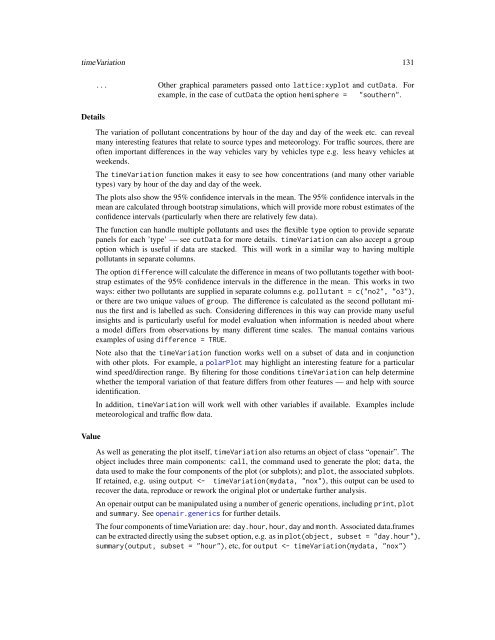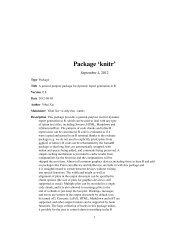Package 'openair'
Package 'openair'
Package 'openair'
You also want an ePaper? Increase the reach of your titles
YUMPU automatically turns print PDFs into web optimized ePapers that Google loves.
timeVariation 131... Other graphical parameters passed onto lattice:xyplot and cutData. Forexample, in the case of cutData the option hemisphere = "southern".DetailsValueThe variation of pollutant concentrations by hour of the day and day of the week etc. can revealmany interesting features that relate to source types and meteorology. For traffic sources, there areoften important differences in the way vehicles vary by vehicles type e.g. less heavy vehicles atweekends.The timeVariation function makes it easy to see how concentrations (and many other variabletypes) vary by hour of the day and day of the week.The plots also show the 95% confidence intervals in the mean. The 95% confidence intervals in themean are calculated through bootstrap simulations, which will provide more robust estimates of theconfidence intervals (particularly when there are relatively few data).The function can handle multiple pollutants and uses the flexible type option to provide separatepanels for each ’type’ — see cutData for more details. timeVariation can also accept a groupoption which is useful if data are stacked. This will work in a similar way to having multiplepollutants in separate columns.The option difference will calculate the difference in means of two pollutants together with bootstrapestimates of the 95% confidence intervals in the difference in the mean. This works in twoways: either two pollutants are supplied in separate columns e.g. pollutant = c("no2", "o3"),or there are two unique values of group. The difference is calculated as the second pollutant minusthe first and is labelled as such. Considering differences in this way can provide many usefulinsights and is particularly useful for model evaluation when information is needed about wherea model differs from observations by many different time scales. The manual contains variousexamples of using difference = TRUE.Note also that the timeVariation function works well on a subset of data and in conjunctionwith other plots. For example, a polarPlot may highlight an interesting feature for a particularwind speed/direction range. By filtering for those conditions timeVariation can help determinewhether the temporal variation of that feature differs from other features — and help with sourceidentification.In addition, timeVariation will work well with other variables if available. Examples includemeteorological and traffic flow data.As well as generating the plot itself, timeVariation also returns an object of class “openair”. Theobject includes three main components: call, the command used to generate the plot; data, thedata used to make the four components of the plot (or subplots); and plot, the associated subplots.If retained, e.g. using output
















